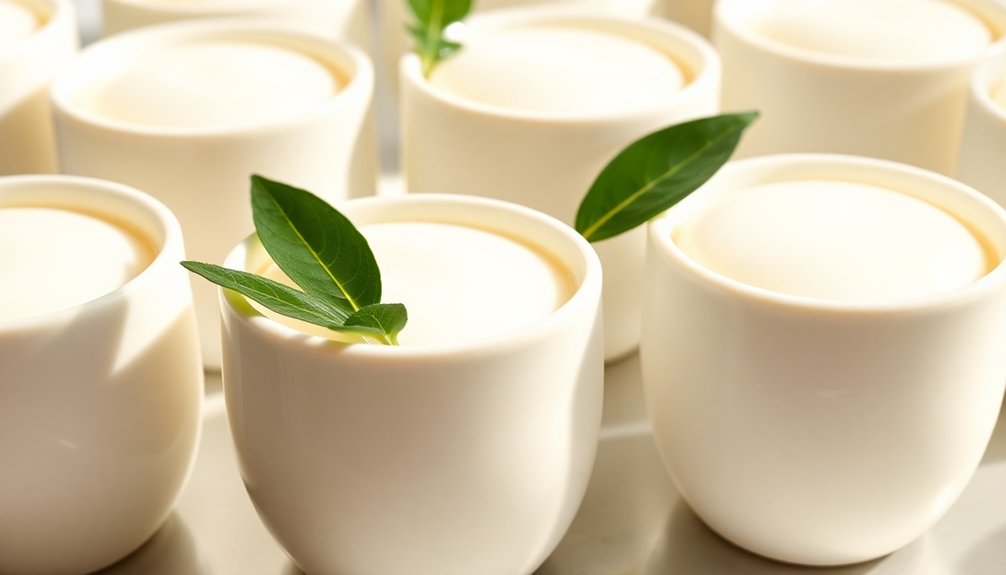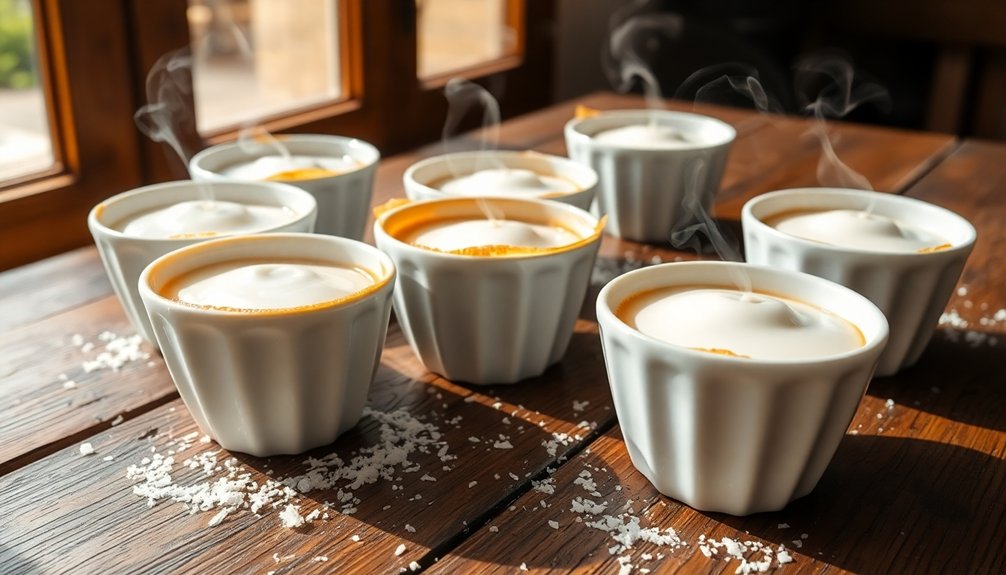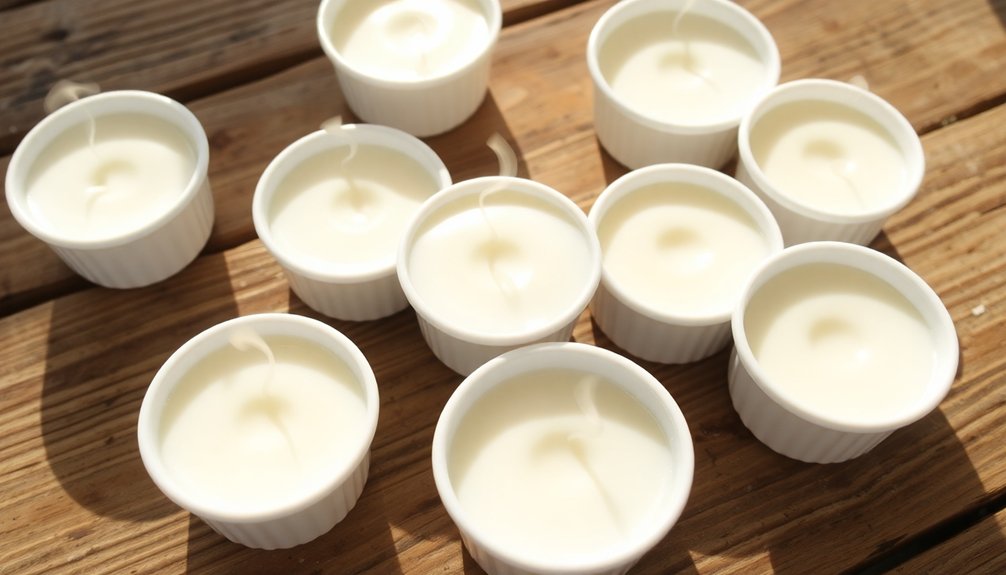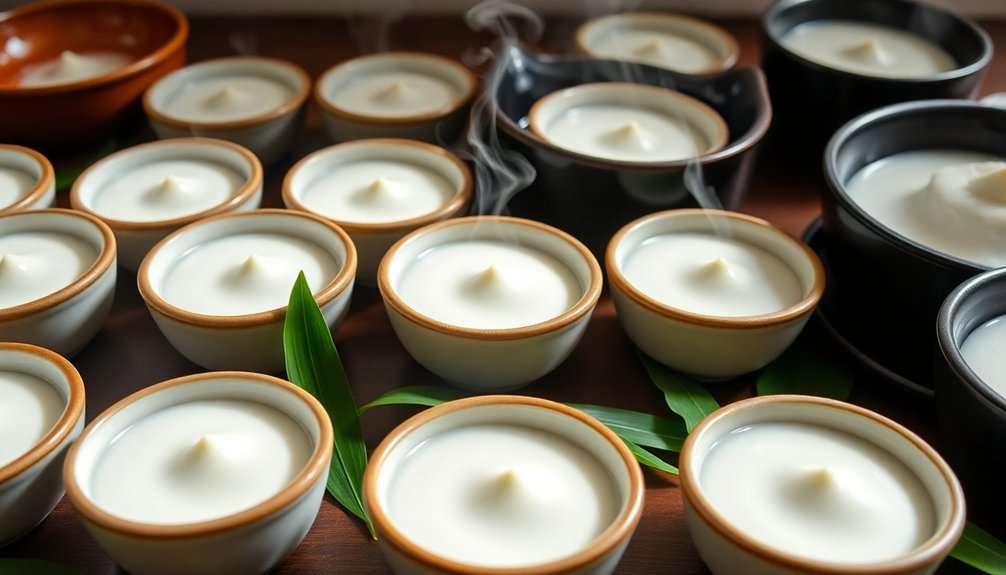Khanom Thuai – Steamed Coconut Cups
Khanom Thuai are traditional Thai steamed coconut cups originating from the Ayutthaya period. You’ll combine rice flour and tapioca starch with coconut milk, sugar, and pandanus extract, then steam the mixture in ceramic cups for 15-20 minutes. Control your steaming temperature carefully—avoid lifting the lid during the first 10 minutes. Serve these delicate treats on banana leaves with toasted coconut for an authentic experience. The balance of subtle sweetness and smooth texture reveals Thailand’s rich culinary heritage.
Key Takeaways
- Khanom Thuai is a traditional Thai steamed dessert made with rice flour, coconut milk, and sugar in ceramic cups.
- The dessert originated during Thailand’s Ayutthaya period (1350-1767) and holds cultural importance in ceremonies and celebrations.
- Preparation involves creating a smooth batter, pouring into cups, and steaming for 15-20 minutes until custard-like.
- Temperature control is critical—steam over medium heat without lifting the lid during the first 10 minutes.
- Traditional serving includes drizzling with coconut cream and garnishing with toasted coconut on banana leaves.
History

Despite the absence of definitive historical records, Khanom Thuai‘s origins can be traced to central Thailand during the Ayutthaya period (1350-1767).
You’ll find this dessert’s preparation techniques evolved as trade routes expanded throughout Southeast Asia, introducing palm sugar and coconut milk as staple ingredients in Thai desserts.
The ceramic cups (“thuai”) traditionally used for steaming lend the dessert its name and reflect Thailand’s historical pottery craftsmanship.
By the late 18th century, Khanom Thuai had secured its position in royal cuisine, where precise layering techniques distinguished palace versions from commoners’ preparations.
The dessert’s cultural significance extends beyond mere sustenance—it features prominently in merit-making ceremonies at Buddhist temples and in ancestral offerings during important festivals, representing the continuity of Thai culinary heritage across generations.
Recipe

Ingredients
- 280g rice flour
- 30g tapioca starch
- 550ml coconut milk
- 200g sugar
- 1/4 tsp salt
- Pandanus leaves
- Ripe jackfruit pieces
For topping:
- 200ml coconut cream
- Pinch of salt
Instructions
- Mix rice flour and tapioca starch in a bowl.
- Heat coconut milk with sugar and salt until sugar dissolves, but don’t boil.
- Gradually pour the warm coconut milk into the flour mixture, stirring continuously to prevent lumps.
- Strain the mixture to guarantee smoothness.
- Add pandanus extract for color and aroma.
- Heat small ceramic cups in a steamer for 5 minutes.
- Pour the batter into the heated cups, about 3/4 full.
- Place small pieces of jackfruit on top.
- Steam on medium heat for 15-20 minutes until set.
- Mix coconut cream with salt for topping.
- Pour a spoonful of the coconut cream topping over each khanom before serving.
Cooking Steps

To prepare Khanom Thuai, you’ll first create a smooth batter by combining rice flour with the coconut milk mixture, ensuring no lumps remain.
You must then pour this batter into small banana leaf cups and steam them until they’ve set completely, typically 15-20 minutes at medium heat.
Once cooked, sprinkle finely chopped scallions on top for a vibrant green contrast before completing the dessert with a generous drizzle of coconut sugar syrup.
Step 1. Prepare Batter With Flour
Preparing the batter for Khanom Thuai begins with precise flour measurements that form the foundation of this traditional Thai dessert.
Combine 1 cup of rice flour with ¼ cup of arrowroot flour in a medium bowl. The combination of these flour types creates the signature chewy yet tender texture characteristic of authentic Khanom Thuai.
Gradually add 2 cups of room temperature water while whisking continuously to prevent lumps. You’ll need to achieve a smooth batter consistency similar to thin cream.
If the mixture appears too thick, add water one tablespoon at a time. Conversely, if it’s too runny, incorporate small amounts of rice flour until corrected.
Strain the batter through a fine-mesh sieve to remove any remaining flour clumps, ensuring your final dessert will have the silky texture that defines perfect Khanom Thuai.
Step 2. Add Coconut Milk Mixture
With the flour batter prepared and strained to silky perfection, you’ll now need to create the coconut milk mixture that gives Khanom Thuai its rich, aromatic character.
In a separate pot, combine 2 cups of coconut milk with 1/2 cup of palm sugar and 1/4 teaspoon of salt. Heat the mixture over medium-low heat, stirring constantly until the palm sugar completely dissolves.
Don’t allow the mixture to boil, as this can separate the coconut milk and diminish its creamy texture. The coconut milk benefits the dessert not only with its distinctive flavor but also by adding a luxurious mouthfeel.
Once your sugar is fully incorporated, remove from heat and let it cool slightly before gradually folding it into your flour batter. Stir gently in one direction to maintain the air bubbles that will help create the dessert’s characteristic layers.
Step 3. Steam in Banana Cups
Traditional Khanom Thuai preparation requires steaming the batter in small, cup-shaped containers, which can be made from fresh banana leaves.
To create these vessels, cut banana leaves into 4-inch squares, fold the corners inward, and secure with toothpicks. The natural compounds in banana leaves impart subtle flavor while providing antimicrobial banana benefits to your dessert.
Fill each cup to about ¾ capacity with your prepared batter. Arrange cups in a bamboo or metal steamer, ensuring they don’t touch. Cover and steam over medium-high heat for 15-20 minutes until the centers are set but still have a slight jiggle.
Master steaming techniques by maintaining consistent heat and avoiding lifting the lid during cooking, which disrupts temperature and extends cooking time. A properly steamed Khanom Thuai will have a smooth, glossy surface.
Step 4. Add Scallions for Color
To enhance the visual appeal of your Khanom Thuai, scallions provide an ideal natural coloring agent while contributing subtle aromatic notes.
Finely chop the green parts of fresh scallions, then blend them with a tablespoon of water to extract their vibrant pigment. Strain this mixture through a fine mesh sieve, pressing gently to yield a concentrated green liquid.
Add this scallion extract to one-third of your prepared coconut batter, stirring thoroughly to distribute the color evenly. The scallion benefits extend beyond aesthetics—they introduce a delicate onion flavor that complements the dessert’s sweetness.
When pouring the batter into banana cups, alternate between plain and green portions to create striking color contrast. This technique transforms your Khanom Thuai into a visually distinctive treat while maintaining traditional flavor profiles.
Step 5. Top With Coconut Sugar
The final touch for your colorful Khanom Thuai creation involves a generous application of coconut sugar, which adds both flavor complexity and textural contrast.
Sprinkle approximately 1-2 teaspoons of finely shaved coconut sugar over each cup while they’re still warm, allowing it to partially melt into the surface.
Coconut sugar benefits extend beyond mere sweetness—its lower glycemic index and retention of minerals like potassium and zinc make it nutritionally superior to refined sugar.
Its caramel-like flavor profile enhances the dessert’s traditional character while complementing the coconut undertones.
For topping alternatives, consider palm sugar, which offers similar complexity, or muscovado for a deeper molasses note.
In more contemporary presentations, you might incorporate lightly toasted sesame seeds alongside your chosen sweetener for added textural dimension and nutty depth.
Cooking Tips

Successful preparation of Khanom Thuai requires precise temperature control and careful timing throughout the cooking process. Steam your desserts over medium heat to achieve the perfect custard-like texture; high heat will cause uneven cooking while low heat won’t properly set the mixture.
When adjusting your cooking techniques, maintain water at a gentle simmer rather than a rolling boil.
For ingredient substitutions, you can replace coconut milk with pandan-infused dairy milk in a pinch, though authentic flavor will be compromised. If palm sugar isn’t available, use brown sugar mixed with molasses.
Pre-warm your molds to prevent temperature shock which causes sinking centers. Ascertain the steamer is properly preheated before adding the cups, and don’t lift the lid during the first 10 minutes of steaming.
Final Thoughts

Mastering Khanom Thuai represents a journey through Thailand’s rich culinary heritage, requiring both technical precision and cultural appreciation.
When you’ve perfected this delicate dessert, you’re honoring generations of Thai culinary expertise that dates back to the Ayutthaya period.
The cultural significance of Khanom Thuai extends beyond its taste—it’s often prepared for merit-making ceremonies and important celebrations.
Consider serving suggestions that enhance its traditional character: present these delicate cups on banana leaves with a sprinkle of toasted coconut, or alongside fresh tropical fruits for contrast.
Remember that patience yields the best results.
The perfect Khanom Thuai balances textures and flavors in a manner that reflects Thailand’s nuanced approach to sweetness—subtle yet deeply satisfying, complex yet harmonious.
Frequently Asked Questions
How Long Can Khanom Thuai Be Stored?
You’ll achieve ideal shelf life by refrigerating for 2-3 days maximum. Don’t freeze them—the delicate texture deteriorates. Follow proper storage tips: cover tightly and consume promptly for best quality.
Is Khanom Thuai Suitable for People With Gluten Intolerance?
While many commercial desserts contain gluten, you’ll find traditional khanom thuai gloriously accessible. It’s made with gluten-free ingredients like rice flour and coconut milk, avoiding wheat-based alternative flours completely.
What Drinks Pair Well With Khanom Thuai?
For ideal pairing with traditional desserts containing coconut milk, you’ll find Thai iced tea, fresh coconut water, or unsweetened green tea effectively balance the sweetness while enhancing the tropical flavor profile.
Can Khanom Thuai Be Frozen and Reheated?
You’ll regret freezing these delicate treats! While technically possible, freezing techniques compromise texture greatly. For best results, consume fresh. If necessary, use gentle microwave reheating methods at low power settings.
Are There Regional Variations of Khanom Thuai Across Thailand?
You’ll find distinct regional differences across Thailand, where northern variations typically use palm sugar while southern preparations incorporate richer coconut cream. These flavor variations often reflect local ingredient availability and cultural influences.
